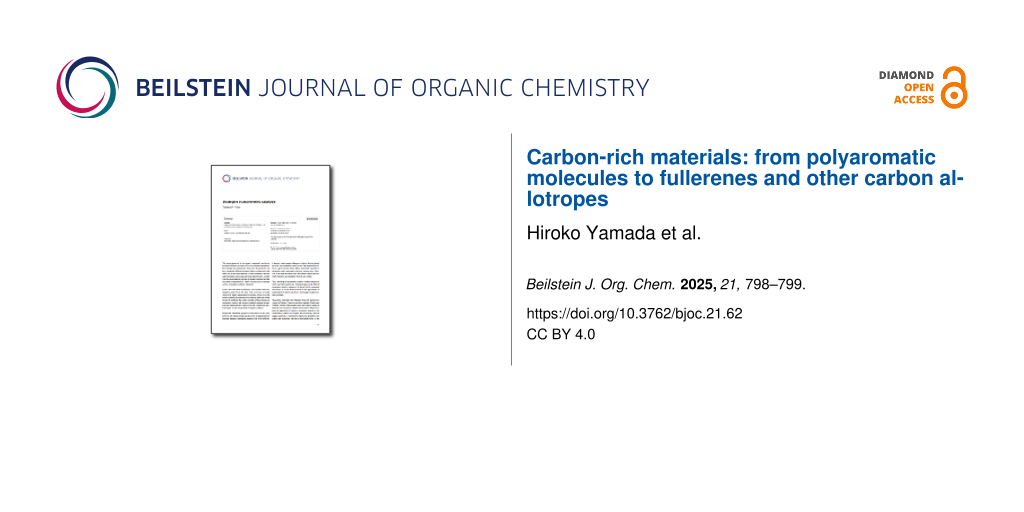In addition to diamond and graphite, traditional carbon allotropes in our old high-school textbook, new types of carbon allotropes, molecular carbons, were discovered in the last decades. These include fullerenes (1985) [1], carbon nanotubes (1991) [2], and graphene (2004) [3]. Due to their unique electronic and photophysical properties, research in the area of carbon-rich molecules and polyaromatic molecules became explosive in their activity and a numerous new studies and directions have emerged. Because of dramatic expansion and development of these research areas, these molecules became targets of Nobel Prizes in Chemistry (in 1996 to Carl, Kroto, and Smalley for the discovery of C60) and in Physics (in 2010 to Geim and Noboselov for the discovery of graphene).
Prior to the celebration of the 40th anniversary of the discovery of fullerene in 2025, we planned this thematic issue on carbon-rich materials. We highly appreciate that so many of our colleagues and friends – researchers with a variety of backgrounds working on these special molecules – agreed to contribute to this project.
The authors hail from diverse research areas, including synthetic organic chemistry, surface chemistry, computational chemistry, physics, electrochemistry, polymer chemistry, supramolecular chemistry, and biochemistry. All are working on fascinating topics associated with these exciting molecules. Furthermore, the authors come from all over the world, not only from Switzerland and Japan but also from China, Denmark, Estonia, France, Spain, Turkey, and USA.
We hope that the readers will enjoy this thematic issue and be inspired to further develop their own research in the near future.
Hiroko Yamada and Yoko Yamakoshi
Kyoto, Zurich, February 2025
Data Availability Statement
Data sharing is not applicable as no new data was generated or analyzed in this study.
References
-
Kroto, H. W.; Heath, J. R.; O’Brien, S. C.; Curl, R. F.; Smalley, R. E. Nature 1985, 318, 162–163. doi:10.1038/318162a0
Return to citation in text: [1] -
Iijima, S. Nature 1991, 354, 56–58. doi:10.1038/354056a0
Return to citation in text: [1] -
Novoselov, K. S.; Geim, A. K.; Morozov, S. V.; Jiang, D.; Zhang, Y.; Dubonos, S. V.; Grigorieva, I. V.; Firsov, A. A. Science 2004, 306, 666–669. doi:10.1126/science.1102896
Return to citation in text: [1]
| 1. | Kroto, H. W.; Heath, J. R.; O’Brien, S. C.; Curl, R. F.; Smalley, R. E. Nature 1985, 318, 162–163. doi:10.1038/318162a0 |
| 3. | Novoselov, K. S.; Geim, A. K.; Morozov, S. V.; Jiang, D.; Zhang, Y.; Dubonos, S. V.; Grigorieva, I. V.; Firsov, A. A. Science 2004, 306, 666–669. doi:10.1126/science.1102896 |
© 2025 Yamada and Yamakoshi; licensee Beilstein-Institut.
This is an open access article licensed under the terms of the Beilstein-Institut Open Access License Agreement (https://www.beilstein-journals.org/bjoc/terms), which is identical to the Creative Commons Attribution 4.0 International License (https://creativecommons.org/licenses/by/4.0). The reuse of material under this license requires that the author(s), source and license are credited. Third-party material in this article could be subject to other licenses (typically indicated in the credit line), and in this case, users are required to obtain permission from the license holder to reuse the material.









